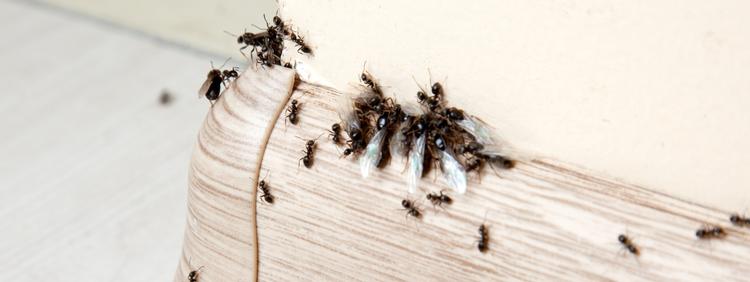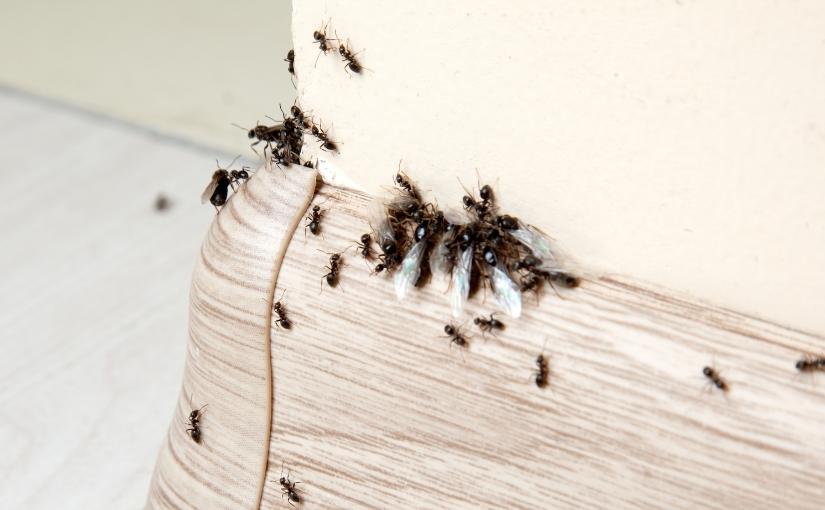
What do you do when you walk into the kitchen and discover a line of ants marching from the countertop to the floor? The sight might surprise you, but keeping these pests away could be as easy as keeping counters clean and clear — unless they are carpenter ants. Carpenter ant pest control is a whole different story.
Getting rid of carpenter ants can be a challenge, but it’s possible. The best way to take on carpenter ant pest control in Cambridge is by first knowing how they get into your home.
How Carpenter Ants Find Their Way Inside
Carpenter ants can damage your home’s structure as they chew up and excrete wood found in your framing, foundation and furniture. But chewing their way into your home isn’t the carpenter ant’s only way inside. Here are six ways these pests can break in.
1. Cracks and Seams
Though you may not feel a draft, your home is filled with tiny seams between windows, doors and walls that carpenter ants can exploit. Ants can even find space along poorly sealed pipes that enter the home. Cracks caused by foundational shifts are also an open invitation for ants and other insects to venture inside.
2. Windows
From spring through fall, it’s wonderful to open windows and let fresh air fill the house. Those open windows, however, create the perfect opportunity for carpenter ants to make their way inside. Wet weather may moisten a wood frame, giving the ants just what they want.
3. Doors
Open doors and broken seals are an easy way for pests to peek in. Making sure seals are properly maintained will help keep ants at bay. Also, check doors that aren’t used often. Infrequent use can lead to dry and deteriorated threshold seals. And with minimal foot traffic as a deterrence, carpenter ants are more than happy to slip on through.
4. Floors
Hardwood floors are a popular feature in many homes and a good opportunity for carpenter ants to take a foothold in your home. Softened wood or moisture-damaged floorboards are attractive locations to build paths — or even a colony. A dehumidifier will help keep wood floors dry, leaving ants uninterested in your home.
5. Foundation Gaps
Even the best-built foundations aren’t perfectly airtight. Moisture that lingers around the foundation might be enough to attract a carpenter ant colony. If this scenario occurs, it is only a matter of time before they figure out how to maneuver through the foundation and get into the house. Use caulk to seal gaps and keep these insects at bay.
6. House Plants
You may even find carpenter ants in house plants and potting soil you’ve brought home from a nursery. Usually, this scenario occurs because honeydew-producing insects have already infested the plants. Honeydew is a sweet substance that insects excrete as they feed, and ants love honeydew. Stop an infestation by using an insect trap or setting up a bait station.
Carpenter Ant Pest Control and the Four Seasons Approach
One of the best ways to ensure carpenter ants keep their distance is by enlisting the aid of a professional. Experts can assess your unique situation and develop a plan to get rid of carpenter ants already in your home and keep them away once they are gone.
Truly Nolen Canada’s Four Seasons strategy takes a year-round approach to residential pest control. Experts factor in the seasonal activity of carpenter ants, from their initial spring activity through the more dormant winter months. They then develop and apply the right mixture of materials necessary for each season. The methodology also disrupts reproduction cycles, reducing the pest population year after year.
If you are ready to learn more about how to keep carpenter ants out of your home or want more details about Truly Nolen Canada’s Four Seasons pest control approach, call or visit Truly Nolen Canada today.
